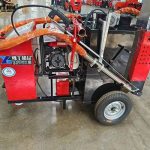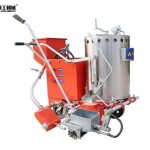Crack filling machine is a specialized piece of equipment designed to dispense hot melt sealants into pavement cracks, preventing water infiltration and further deterioration. These machines range from small, portable units suitable for minor repairs to large, self-propelled models designed for extensive road maintenance projects. The fundamental principle behind their operation is to heat sealant materials, such as asphalt rubber or polymer-modified asphalt, to a specific temperature and then apply them under pressure into the cracks.
Key Components of Asphalt Crack Sealing Machine
Melting Tank: Heats and stores the sealant.
Agitator: Ensures uniform heating and prevents settling.
Pump: Delivers the sealant to the application nozzle.
Application Wand/Nozzle: Directs the sealant into the cracks.
Temperature Control System: Maintains the sealant at the optimal application temperature.
Selecting the Right Crack Filling Machine
Choosing the right asphalt crack sealing machine depends on several factors, including the project scale, the type of sealant used, and the specific requirements of the job site.
Project Scale:
For small repairs or parking lot maintenance, a melter applicator or a portable machine may suffice.
For large-scale road maintenance projects, a self-propelled or oil-jacketed melter is recommended.
Mobility and Maneuverability:
For projects in confined spaces or areas with limited access, a portable or compact machine is essential.
Cost-Effectiveness:
Consider the initial investment, operating costs, and long-term return on investment.
Why Is Crack Sealing Machine Important in Modern Infrastructure?
Preventing Costly Repairs: Unsealed cracks allow water infiltration, leading to potholes, base erosion, and structural failure.
Safety Compliance: Smooth surfaces reduce trip hazards and liability risks.
Sustainability: Proper sealing minimizes the need for frequent resurfacing, cutting material waste by up to 40%.
Features to Consider When Choosing a Crack Filler Machine
Application Rate and Efficiency:
How quickly the machine can fill cracks.
Impact on project timelines and labor costs.
Portability and Maneuverability:
Importance for different job site sizes.
Features like wheel size, weight, and handle design.
Capacity and Hopper Size:
Matching hopper size to project needs.
Reducing downtime for material refills.
Benefits of Using Crack Filling Machine
Increased Efficiency and Productivity:
Faster crack filling compared to manual methods.
Reduced labor costs and time.
Improved Repair Quality:
Consistent application and material distribution.
Longer-lasting repairs and reduced need for rework.
Enhanced Safety:
Minimizing manual labor in hazardous environments.
Reducing the risk of accidents and injuries.
Cost-Effectiveness:
Long-term savings through durable repairs.
Reduced material waste and optimized usage.




